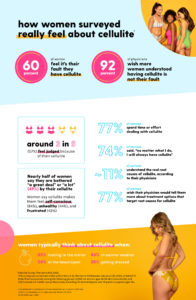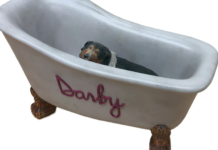Sixty percent (60%) of women surveyed feel it’s their fault they have cellulite and 57% feel judged for their cellulite,i according to new Harris Poll survey results released today by Endo Aesthetics LLC, an affiliate of Endo International plc (NASDAQ: ENDP). Conversely, 92% of physicians surveyed wish more women understood having cellulite is not their fault. Although celluliteii is common, many women are unsure about its root causes, lack knowledge about treatment options and feel a sense of blame and judgment for having cellulite.
The Harris Poll survey was conducted online among 2,006 U.S. women and captured feedback from those ages 18-59 who have cellulite, as well as 302 board certified dermatologists and plastic surgeons. Harris polled the women and physicians about their experience with cellulite and current treatment options.
Of aesthetic physicians surveyed, 93% said most women want to know how to improve their cellulite. Additionally, one-third of women surveyed (34%) feel that having information on what does and does not cause cellulite would make it easier to have conversations with their physician about this topic.
“It doesn’t surprise me that 60% of women surveyed feel it’s their fault they have cellulite,” says Lisa Donofrio, MD, a New Orleans based board-certified dermatologist, past president and board member of the American Society for Dermatologic Surgery, and a fellow of the American Academy of Dermatology. “I’ve consulted with patients who are embarrassed and frustrated with having cellulite; however, I want them to know that they are not alone. In fact, 80% of women surveyed said they have cellulite and over three-quarters of them noted they spend time or effort focused on it. It’s a very common issue that can stem from a variety of factors, including but not limited to hormones, genetics, skin structure and skin texture.”
Cellulite can have a negative impact on how women perceive themselves. Nearly half of women surveyed (49%) say they are bothered “a great deal” or “a lot” by their cellulite. Women most commonly think about their cellulite at certain times, including when looking in the mirror (65%), at the beach or pool (54%) and during warmer weather (46%).iii
“The Harris Poll survey results reinforce that many women are looking for trusted information and resources from their healthcare professionals,” says Robert Catlin, Vice President of Aesthetic Sales and Marketing at Endo. “We undertook this survey to understand how women feel about their cellulite and to help remove the blame and replace it with data and information.”
Additional highlights from the Harris Poll survey include:iv
- 67% of women surveyed are frustrated that no amount of exercise seems to get rid of their cellulite;
- 57% of women surveyed have given up on trying to improve their cellulite because nothing has worked;
- 92% of physicians surveyed wish women better understood the root causes of cellulite; and
- 77% of women wish their physician would tell them more about treatment options that target root causes for cellulite.
Scientists continue to explore treatments that target the root causes of cellulite in minimally invasive ways.i Currently, surgical and invasive options get to the bands under the skin’s surface that can cause cellulite.ii The Harris Poll survey showed many of the women surveyed tried to improve their cellulite using various methods, including exercise (71%), diet (58%), topical treatments (36%), massages (25%) and in-office procedures (12%). By releasing the Harris Poll survey results, Endo Aesthetics is seeking to clear up the misinformation that exists around the etiology of cellulite, which may be one of the reasons 74% of women surveyed said that “no matter what I do, I will always have cellulite.”v
 About Cellulite
About Cellulite
Cellulite is a localized alteration in the contour of the skin that has been reported in over 90 percent of post-pubertal females and affects women of all races and ethnicities.vi,vii The presence of cellulite is associated with changes in dermal thickness, and in the fat cells and connective tissue below the skin. A primary factor in the cause of the condition is the collagen containing septae which attach the skin to the underlying fascia layers. The septae tether the skin which, with additional contributing protrusions of subcutaneous fat, causes the surface dimpling characteristic of cellulite.viii,ix These fibrous septae are oriented differently with varying thickness in females than in males, which helps our understanding of cellulite as a gender-related condition.xi Cellulite clinically presents on the buttocks, thighs, lower abdomen and arms.
It is known that cellulite is different from generalized obesity. In generalized obesity, adipocytes undergo hypertrophy and hyperplasia that is not limited to the pelvis, thighs, and abdomen.x In areas of cellulite, characteristic large, metabolically stable adipocytes have physiologic and biochemical properties that differ from adipose tissue located elsewhere. An anatomical study in 2019 found that women have increased fat lobule height compared with men, which may also contribute to the mattress-like appearance seen as a result of the tension of the fibrous septae.xi Weight gain can make cellulite more noticeable, but it may be present even in thin subjects.
Research Method
This survey was conducted online within the U.S. by The Harris Poll between January 2, 2020 and January 26, 2020 on behalf of Endo Pharmaceuticals among two groups: 2,006 women, ages 18-59 who have cellulite; and 302 licensed U.S. healthcare professionals, including 151 dermatologists and 151 plastic surgeons.
Patient data were weighted by age, education, race/ethnicity, region, income, household size, marital status, and employment status to be representative of the broader population. Propensity score weighting was also used to adjust for respondents’ propensity to be online. Dermatologist and plastic surgeon data were weighted by gender, years in practice, and region, and a post-weight was applied to the total data to reflect the prop
References:
i Endo Pharmaceuticals data on file 2020. Cellulite Survey: Women and HCP Survey Results, The Harris Poll online survey, 1/2/20 – 1/26/20 of 2,006 U.S. women ages 18-59 who have cellulite and 302 U.S. licensed physicians aged 18+
ii Zerini I et al. Cellulite treatment: a comprehensive literature review. J Cosmet Dermatol. 2015 Sep 14(3):224-40
iii Endo Pharmaceuticals data on file 2020. Cellulite Survey: Women and HCP Survey Results, The Harris Poll online survey, 1/2/20 – 1/26/20 of 2,006 U.S. women ages 18-59 who have cellulite and 302 U.S. licensed physicians aged 18+
iv Endo Pharmaceuticals data on file 2020. Cellulite Survey: Women and HCP Survey Results, The Harris Poll online survey, 1/2/20 – 1/26/20 of 2,006 U.S. women ages 18-59 who have cellulite and 302 U.S. licensed physicians aged 18+
v Endo Pharmaceuticals data on file 2020. Cellulite Survey: Women and HCP Survey Results, The Harris Poll online survey, 1/2/20 – 1/26/20 of 2,006 U.S. women ages 18-59 who have cellulite and 302 U.S. licensed physicians aged 18+
vi Hexsel, D., & Mazzuco, R. (2013). Cellulite. Update in Cosmetic Dermatology, p.2
vii Khan MH et al. Treatment of cellulite: Part I. Pathophysiology. J Am Acad Dermatol. 2010 Mar;62(3):361-70.
viii Querleux B et al. Anatomy and physiology of subcutaneous adipose tissue by in vivo MRI and spectroscopy: Relationship with sex and presence of cellulite, Skin Research and Technology; 8: 118-124.
ix Querleux B et al. Anatomy and physiology of subcutaneous adipose tissue by in vivo MRI and spectroscopy: Relationship with sex and presence of cellulite, Skin Research and Technology; 8: 118-124.
x Khan MH, Victor F, Rao B, Sadick NS. Treatment of cellulite: Part I. Pathophysiology. J Am Acad Dermatol 2010;62(3):361-370
xi Rudolph C, Hladik C, Hamade H, Frank K, et al. Structural gender-dimorphism and the biomechanics of the gluteal subcutaneous tissue – implications for the pathophysiology of cellulite. Plast Reconstr Surg 2019; 143: 1077-86.





